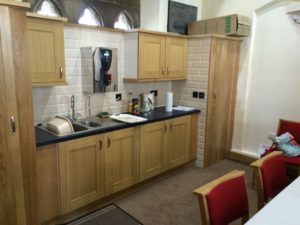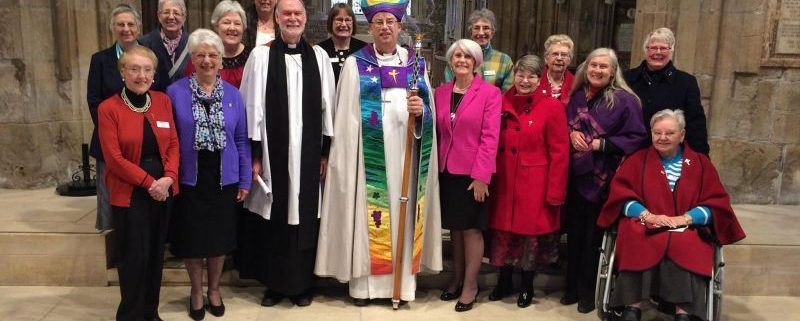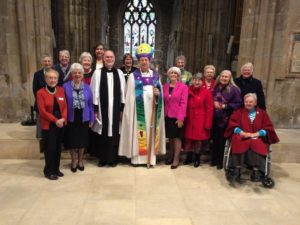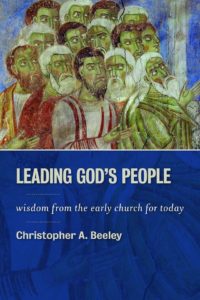Welcome Eucharists
Psalm 96; Matthew 5.1-10
Thank you so much for your welcome. It is very good to be here.
I’m deeply thankful for the Church in these three counties. I have experienced good things over many years. I am enjoying working with Bishop Colin, Alan and Andrew and the rest of the senior team. I have come initially to listen and to learn. I am an imperfect bishop in an imperfect church but together we serve the God who makes all things new.
To all of you from across this county, clergy and lay ministers and wardens and officers and every disciple: thank you for all you give to the life of the local church and to mission in the new community. Please pray for me. It will take me a while to visit every place but I look forward so much to being with you.
This season marks a new beginning for me and a new beginning in the long story of the Diocese of Oxford. As Christians we should not be strangers to these new beginnings.
The Psalms mean a great deal to me as I expect they do to you. For this nine months I have been trying to dwell in a particular verse from Psalm 96 and to hear what God is saying to me through this part of scripture.
We heard it read earlier. This is my calling and our calling.
“Sing to the LORD a new song; sing to the LORD all the earth
Sing to the LORD, bless his name, tell of his salvation from day to day”.
The whole of creation is summoned to worship and to joy. The kingdom of God is breaking in: the kingdom of justice and mercy and peace.
One of the wonders of being alive is that life never stands still. Our lives are constantly changing. Each day there are new blessings to appreciate, new wonders to discover, new adventures to be had. There is nearly always a new song to sing.
I have recently taken up running for the first time in my life since primary school. It certainly surprised my family. I went to one of those fancy shops and bought some proper running shoes. I downloaded an app to my phone which claimed it would take me from 0 to 5 K in 8 weeks. I started very tentatively. Everyone thought I would give up after three weeks. Rather to my surprise, I’m enjoying it. I ran 5 K just this morning and completed the app.
A few weeks ago I sent a text to my children to say I’d been for a run and posted a picture of my muddy running shoes on our family Whatsapp. One of my sons texted back: “Who is this and what have you done with my dad”. My other new hobby for the summer has been learning how to make pies. The two things sort of balance each other out.
Sing to the LORD a new song, Sing to the Lord all the earth.
As God’s people we should be ready for new things. That is not always how people see us. There is a story told in my native Yorkshire about a dialogue between a Bishop and a Churchwarden. Bishop: How long have you held office.
Warden: About forty years Bishop.
Bishop: You must have seen a lot of changes in that time
Warden: Aye and I’ve opposed every one of them.
There is more in this text than the call to embrace change and variety and experience the richness of God’s love and God’s gifts..
Psalm 96 is not directed to the Church. Psalm 96 is a call to the whole world. Through the words of Psalm 96, God’s people are singing to all the earth and summoning the world to newness and to joy.
O sing to the LORD a new song; sing to the LORD all the earth
Sing to the LORD, we say to all who will listen, bless his holy name; tell of his salvation from day to day”.
Rarely has that new song been more needed in our nation and in our world. Year by year, the earth’s climate is changing. We are living in the midst of the greatest human migration in history. In every country including our own there are questions of identity. Who are we as a nation? Inequality grows year by year. The world faces immense challenges.
What kind of a song are we called to sing as a Church in such a time?
When the world is being shaken, we must sing a new song of hope
When the world is hurting, we must sing the new song of healing and salvation.
When the world grieves, we sing new songs of resurrection.
When the world grows more unfair, we must sing God’s new song of justice.To those who are enslaved and prisoners, we teach new songs of freedom
To those who are afraid, we share our songs of courage
To those who are dragged down by sin, we sing of God’s forgiveness
To those who are confused we sing God’s clear new song of truthIn this divided world, our songs reach out to strangers, to welcome and build bridges.
In this restless world, our songs tell of God’s peace and our final rest in heaven
In this polluted world, we sing a new song of care for God’s creation
In this world of vanity and pride, we sing songs of humility and meekness
In a world which lives for itself, we sing of love of God and neighbour.
The song we sing is the song of the gospel of Jesus Christ. It is a song of great power and love. Perhaps we do not sing it very well or as clearly as we could. Perhaps we have forgotten its immense potential to transform human life. Perhaps we have lost confidence in the immense importance of the message entrusted to the Church. We need to find our voice again.
I look forward to working in partnership with all of you across this city in the coming years in all parts of the city. One of the concerns I will bring as Area Bishop here and as Diocesan Bishop is a concern that we teach the faith well to adults, to enquirers, in every context. I look forward to learning what you are doing now and to building together for the future. We need to find our voice.
[In 1963, at the height of the American Civil Rights movement, 250,000 people gathered in Washington to urge change and freedom in America. They were addressed by Dr. Martin Luther King. He delivered the speech which began: “I have a dream”. His song is inspired by scripture and by the Christian message. The trio, Peter, Paul and Mary, sang to the crowd. They sang Pete Seeger’s song, If I had a hammer. They sang of the hammer of justice, the bell of freedom, the song about the love between brothers and sisters, all over this land”. Their song helped change the world.]
We need to find our voice again and find the confidence to teach the world a new song. In every part of this Area, God has called a community of Christians to be the Church. In every place, God calls us to sing a new song in the midst of this weary world.
We sing this new song as we gather Sunday by Sunday in every city, town and village. We sing this new song as we are scattered in schools and colleges, workplaces and homes. We sing this new song in the words we speak. We sing this song in the way we live our lives. We sing it as we live the beatitudes of Matthew’s gospel: as we are people who are poor in spirit, compassionate, full of kindness and mercy, hungry and thirst for justice becoming more like Jesus Christ.
And as we sing, and pray and serve and work so God uses our songs for good, to spread his love, to draw others into his family, to be the change we want to see.
“Sing to the LORD a new song; sing to the LORD all the earth
Sing to the LORD, bless his name, tell of his salvation from day to day”.
I look forward so much to working with you and getting to know you in the coming years. Please pray for me and I will pray for you.
I hope that together we will sing a new song to the LORD and to this needy world
Amen.
For a clip of Peter, Paul and Mary singing in Washington in 1963 see Peter Paul & Mary Talk about The March On Washington & Sing








